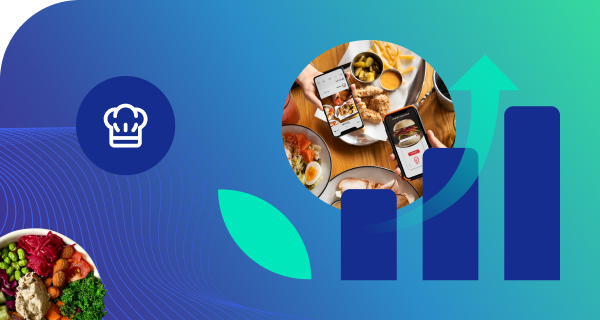Virtual Restaurants in a Post-Pandemic World

Today’s food and beverage ecosystem is feeling the impact of current public health events across all areas. Virtual restaurants are stepping up the plate – read on for a look at the category’s current impact.
Virtual Restaurants in a Post-Pandemic World
In the past five years, once stagnant consumer habits and behaviors began to change at an exponential rate – with no sign of slowing down. The most significant changes lay in the motivations behind consumer choices; the era of functional food arrived, and was firmly established in the mainstream by 2019.
Consumer spending habits also experienced significant change. In 2017, consumers spent, for the first time ever, more money on restaurants than on groceries; the consumer landscape evolved once again as traditional brick-and-mortar restaurant dining began to cede to dine-out and order-in eating.
These changes set an important benchmark for the future of the industry. Then the COVID-19 pandemic hit.
Today’s food and beverage ecosystem is feeling the impact of current public health events across all areas. In-demand products are flying off the shelves as people prepare for the worst; weekly shopping lists now focus on the weeks and months ahead. Traditional buyer/supplier relationships have dried up, and farmers must make tough choices on how to manage product that no one is buying. From news reports on consumer behavior in food and beverage spaces, to cancelled trade shows, to community action around restaurant closures and layoffs, everyone from consumers to industry stakeholders have felt the squeeze and are preparing for the months to come.
The Rise of Delivery
In the last five years, restaurant delivery increased a solid 20% in popularity, and is currently valued at $100B. As consumer spending began to leak away from supermarkets and toward restaurant dining, the delivery category picked up the momentum that would carry it to its current position: an independent, significant category in the food and beverage industry.
With these recent, fundamental changes in consumer behavior, a new opportunity for expanded growth presented itself: restaurants as a conduit for CPGs. Restaurants were well on their way to becoming critical for distribution and brand survival; some CPG companies were opening their own branded restaurant chains, and an entire ecosystem of branded restaurants was poised to emerge. CPGs began to follow the consumer spending transition away from big box stores.
That reality has now been complicated.
In addition the challenges of high rents, bad capex, unpredictable customer relationships and slow growth/scale in brick and mortar restaurants, CPGs, restaurateurs, and their investors now face different, pressing motivations to abandon brick and mortar storefronts entirely.
When will physical restaurants even be able to reopen? What kind of investments will the economy allow?
At the end of 2019, smart food brands were choosing to invest in the newest concept, virtual restaurants, over brick and mortar locations. That choice has now become an urgent prospect that restaurants and brands must consider seriously in order to survive.
Virtual restaurants (VRs), or ‘ghost kitchens’, are ‘dark kitchens’ that only sell on food delivery apps and have no storefront. VRs are more flexible, allowing several restaurant brands to operate from the same kitchen, maximizing revenues, increasing margins, and bolstering expansion possibilities.
As physical restaurant dining rooms are shuttered by health concerns and government mandates, use of delivery platforms has exploded. Consumer interest in delivery in the month of March alone skyrocketed 582%. Since March, that interest has skyrocketed a further 764% MoM, and has grown a jaw-dropping – yet unsurprising – 1,288% since this time last year.
Premised on delivery, lower set-up costs (the average VR costs 25% less to set up than a traditional restaurant) and smaller operating budgets, VRs have become not only a clever tool acknowledged by some innovative brands, but a necessary adaptation for the survival of the hard-pressed restaurant market.
Additionally, CPGs must adapt to this new reality. The market has fractured wide-open to present a new, albeit complicated, opportunity for brands to position their products for a consumer audience with changing motivations, preferences, and behavior.
Virtual Restaurants: The Ghost of the Future
In this evolving industry, companies need robust, real-time resources to make better-informed decisions — especially regarding VRs. At Tastewise, our AI discovers the gaps between demand and supply both at home and in restaurants, allowing brands and restaurateurs to open the right virtual restaurants with the right dishes on the menu for the right audience.
We’ve built an advanced AI platform that translates billions of social media posts, online recipes, and the largest database of restaurant menus (and more!) into analytics and actionable insights. Tastewise taps into this wealth of food and beverage information to unveil what is happening in a hyper-segmented world — down to a specific zip code, and all in real time. Our technology allows users to navigate data on the emerging consumer demands, tastes and motivations relevant to their particular needs, and crucial in today’s climate.
The current food and beverage landscape is murky. Traditional analytic strategies, on their way out of relevance before the world shut down, are now nearly obsolete; models like focus groups are near impossible, and surveys do not capture the dynamism of consumers’ lives, which change daily.
Consumers are ready for new forms of eating and drinking experiences, and restaurants, brands, and others must be ready to provide for their needs.
Enter the power of real-time data.
In our digitized world, social media, online recipes, delivery menus are more than ever before the proving ground for consumer behavior. With data that was previously unavailable and the technology to analyze it in real-time, Tastewise is at the forefront of industry innovation.
Are you considering moving towards virtual restaurants? Let’s build your success together.
Get in touch at info@tastewise.io

